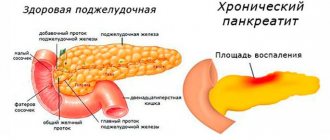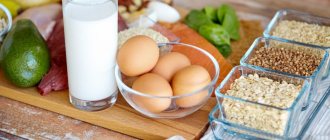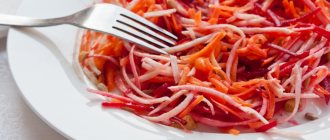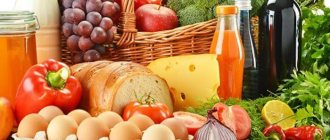Not every stomach upset is accompanied by diarrhea. This term can accompany any digestive disorder or dyspeptic symptoms. A person suffering from indigestion, especially if it occurs with vague symptoms, often does not know how to act to alleviate the unpleasant manifestations of the disease.
The most common causes of indigestion are bacterial damage to the mucous membrane, food poisoning, and an incorrect diet. What should be the diet for an upset stomach?
General rules
The most common symptom of intestinal diseases is diarrhea - frequent (more than 3 times) bowel movements with liquid or pasty stools. With diarrhea, the water content in stool increases to 85%. This symptom is observed in acute intestinal infections, celiac disease , irritable bowel syndrome , ulcerative colitis , Crohn's disease , gastroenteritis , chronic colitis , and intestinal cancer.
Acute diarrhea is observed with intestinal infections, and its duration is no more than 2-3 weeks. All other diseases are chronic with periods of exacerbations and remissions. For all intestinal diseases that occur with diarrhea, Table No. 4 . The purpose of its administration in this condition is to reduce inflammation, fermentation and putrefactive processes and normalize digestion.
A diet for intestinal and stomach disorders significantly limits all possible intestinal irritants: mechanical, chemical and thermal. Products that simulate the secretion of the gastrointestinal tract (stomach, pancreas, liver) and enhance the processes of fermentation and putrefaction are excluded. Dishes are boiled or steamed, served in liquid or pureed form.
Very hot and cold foods are excluded. There are no restrictions on salt (8-10 g), drinking regime is 1.5-2 liters when lazy. Food intake is organized up to 5-6 times a day, in fractional portions and only warm. Due to the reduction of fats (up to 70 g) and carbohydrates (250 g), the diet has a reduced energy value (2000 kcal). At the same time, the normal protein content (90 g) is maintained.
Nutrition for indigestion (intestines) has a number of features:
- six meals a day, the basis of which is mashed, pureed, mushy dishes, slimy soups, which eliminates mechanical irritation of the intestines;
- the inclusion of foods that weaken motor skills: tannin- (blueberries, bird cherry, tea, Cahors, cocoa in water), viscous substances (mucoid soups, jelly, pureed porridges) and warm dishes. Also acceptable are indifferent dishes from lean meats and poultry, boiled lean fish, stale wheat bread, crackers, freshly prepared cottage cheese;
- boiled and steam methods of preparing all dishes;
- Cold food, which increases intestinal motility, is prohibited. Temperature of dishes 20-40°C (warm);
- exclusion of products that enhance fermentation and putrefactive processes, also rich in essential oils (radishes, turnips, radishes, spinach, sorrel, garlic, onions, mushrooms).
Diet for diarrhea in adults
In case of severe diarrhea in adults and children and with severe dyspeptic symptoms, 1-2 “fasting” days are prescribed. You are allowed to drink 1.5-2 liters of liquid - this can be strong, slightly sweetened tea, decoctions of rose hips and medicinal herbs. In the future, treatment Table No. 4 or No. 4A , but since they are physiologically inferior, they are prescribed only for 2-5 days. During this time, acute diarrhea usually stops.
For chronic diseases that occur with diarrhea, as the severity of the process decreases (diarrhea, pain and dyspeptic syndromes), the patient is transferred to a complete Diet No. 4B , which for chronic intestinal diseases is prescribed from 2 months to several years - the criterion is complete normalization of stool. This therapeutic food contains more proteins (100-110 g), fats and carbohydrates.
The list of permitted products has been significantly expanded: you can eat vermicelli, noodles, vegetables include carrots, potatoes, cauliflower, zucchini, cream, sour cream and kefir are allowed, as well as sweet berries and fruits. The same therapeutic nutrition can also be recommended to persons after acute diarrhea to completely restore gastrointestinal function.
After the diarrhea stops (in the remission phase of a chronic disease), patients are prescribed Table No. 4B , in which dishes are consumed in a non-puréed form, and vegetable fats are already included and the amount of butter and the amount of carbohydrates is increased. The list of products includes buns, pies, milk sausage, ham, cabbage, green peas, beets, oranges, grapes, tangerines, strawberries, watermelon, raspberries are allowed. This diet allows you to restore digestive functions. In this way, the digestive tract is prepared and transferred to the basic Diet No. 15 .
Taking into account the predominance of dyspepsia (fermentative or putrefactive) in chronic diarrhea, a correction is made to the basic diet. With fermentative dyspepsia, there is an increased formation of gases in the intestines (bloating, rumbling, uncontrolled, constant release of foul-smelling gases). There is loss of appetite and abdominal pain, fatigue, moderate diarrhea and, at the same time, light-colored stools without pathological impurities.
Fermentative dyspepsia is caused by the predominance of foods rich in easily digestible carbohydrates, which suppress normal flora and promote the growth of aerobic microorganisms. Fermentation of sugars, formation of water, gases and acetic acid are noted.
To reduce fermentation:
- Reduce the amount of carbohydrates (200-250 g, and sometimes up to 150 g) - these are white cereals, sweet fruits, mashed potatoes, starch jelly, dried fruits, sweets (jam, candies, cookies, honey), baked goods.
- Limit the intake of dietary fiber from baked goods with bran, whole grains, nuts, legumes, cabbage, dried fruits, raw vegetables and fruits. This restriction significantly reduces the rate of movement of intestinal contents.
- Sharply limit (exclude) foods that cause gas formation (bananas, grapes, sweet apples, legumes, all varieties of cabbage, milk, cucumbers, oats, turnips, drinks with gas).
- Avoid products with a high content of essential oils (radish, turnip, radish, sorrel, onion, garlic, spinach, mushrooms).
- Increase protein consumption (120-130 g) per set of consumption of boiled meat, fish, protein omelettes, buckwheat and oatmeal.
- Decoctions of medicinal herbs are administered that suppress fermentation in the intestines (mint, chamomile, barberry, dogwood, lingonberry, rose hip, strawberry leaf, calendula, sage). Decoctions begin to be drunk with 50 ml per day, and if well tolerated - up to 200 ml per day in 3-4 doses.
- You can use spices when preparing dishes (bay leaf, cloves, peppers).
- Putrefactive dyspepsia occurs with intoxication (weakness, headache ), spasms and pain in the rectum. Flatulence is not as pronounced, the discharge of gases is much less, but they are more smelly. The stool is liquid or mushy, with a putrid odor, brown in color.
- Putrefactive dyspepsia is caused by prolonged consumption of protein foods, which causes the growth of anaerobes and microbes in the intestines that cause putrefactive processes. Hydrogen sulfide , methane , methyl mercaptan , and indole are formed in the intestines , which irritate the mucous membrane and cause frequent bowel movements.
To reduce putrefactive processes:
- They recommend fasting for 1-2 days. You can drink tea and rosehip decoction.
- Simple carbohydrates are included after 2 days; rice porridge with diluted milk is prescribed (sweets and sugary crackers are excluded) from the 5th day of treatment.
- Fermented milk products and vegetable dishes are required. Yogurt, fermented baked milk, acidophilus and kefir are drunk 100–150 ml up to 4 times a day.
- They limit proteins (30–50 g), therefore reducing the consumption of meat, fish, cottage cheese, cheese, nuts, legumes, eggs, buckwheat, semolina and oatmeal.
- The amount of fat is also reduced (25-30 g), and carbohydrates are increased (400-450 g).
- Increase the intake of dietary fiber by first introducing boiled and then raw vegetables. Vegetarian days are periodically prescribed.
- The growth of anaerobic flora is suppressed by apricot, currant, rowan, cumin, cranberry, as well as infusions of lemon balm, pomegranate, wormwood, galangal, oak bark, alder cones, thyme, oak leaves, sage, dandelion, plantain, so they must be included in the patient’s diet.
Diet for diarrhea in the elderly
During the aging process, there is a disruption of all functions of the gastrointestinal tract. Therefore, with age, not only age-related constipation , but also diarrhea , which is accompanied by dehydration, which is especially dangerous for this age category. In older people, the causes of diarrhea, in addition to those common to all ages ( intestinal infection , poisoning, exacerbation of gastrointestinal diseases), can be serious diseases ( malignant tumor , diabetes mellitus , ulcerative colitis , Crohn's disease ), which requires you to consult a doctor and choose the right diet. Health and life expectancy depend on your diet.
When elderly people have loose stools, the general principles of nutrition remain the same, but great importance must be paid to the drinking regime. Typically, older people drink little liquid, but in this case the amount needs to be increased to 1.2-1.5 liters - this could be a decoction of rose hips and medicinal herbs, a compote of dried pears and quince, frozen dogwood and blueberries, jelly, kefir, sweet weak tea, still mineral water.
Often, weakening can be caused by foods that were previously well tolerated (this is due to enzyme deficiency), and with age it is necessary to make adjustments to the diet. The basis of it, even after stool restoration, should be boiled low-fat soups, boiled fish and chicken meat, cereal casseroles, boiled porridge in water and with the addition of milk, cottage cheese - that is, dishes that are easily digested and do not irritate the gastrointestinal mucosa.
Older people generally do not tolerate fresh vegetables well, and after illness they can cause bloating and increase pain in the intestines; in this case, vegetable purees or stewed vegetables, vegetable casseroles are gradually introduced, since the body must receive fiber. An alternative to fresh fruits can be baked or stewed (apples, pears). In a word, the diet should be constantly gentle and foods that are harmful to an elderly person should be completely excluded: fatty, fried and smoked foods.
For dysbacteriosis with diarrhea
The large intestine is populated by “good” bacteria that inhibit the growth of pathogenic microbes and participate in the digestion of food. Taking antibiotics can cause partial death of the microflora, while the pathogenic flora begins to actively multiply, causing disruption of intestinal function, which is manifested by diarrhea .
For diarrhea after antibiotics , which often begins a few days after the start of taking them, in some cases (if the diarrhea is not very severe), there is no need for special treatment. Normal microflora has the ability to self-heal, and after stopping antibiotics, it quickly recovers. As a rule, in such cases, the stool does not contain blood, and diarrhea is not accompanied by abdominal pain, fever, or deterioration of the condition.
Diarrhea is observed in 10% of patients receiving antibiotics, and in 1% of cases it is caused by pseudomembranous colitis , which is associated with the activation of opportunistic enterobacteria Clostridium difficile. This is already a serious disease. Children are more often carriers of this toxigenic strain, but the disease is less common in them.
More often, pseudomembranous colitis (PMC) develops in patients who take antibiotics for a long time and combine several in one regimen. The risk group includes people over 65 years of age who have pathology of the gastrointestinal tract or have undergone intestinal surgery. There is gradually increasing diarrhea up to 20 times a day. The stool may have a greenish color and an unpleasant odor. Over time it becomes watery with mucus, sometimes with blood.
Development from self-limiting diarrhea to severe colitis with relapses is possible. With persistent diarrhea with MVP, pronounced electrolyte disturbances, a decrease in albumin , and the development of peripheral edema . Thus, the appearance of diarrhea during antibiotic therapy, endogenous intoxication (fever, increasing weakness) and leukocytosis is the basis for the diagnosis of pseudomembranous colitis.
Treatment for this condition includes:
- Intestinal sanitation ( Vancomycin and Metronidazole are most effective against pathogenic flora).
- Elimination of dehydration .
- Sorption therapy (removal of toxins and microbial bodies). Enterosorption is carried out for 7-10 days.
- Restoration of the intestinal ecosystem ( probiotics with lactobacilli Lactobacillus acidophilus and Lactobacillus casei are effective), which is carried out at the end of three stages.
- Therapeutic nutrition, taking into account the type of dyspepsia - fermentative or putrefactive, which was mentioned above.
The effect of protein foods and gluten on FD symptoms
Currently, there is no proven connection between symptoms of FD and protein intake, so protein restrictions are not required for patients with this disease.
As for gluten, several studies have been conducted to identify a possible relationship between eating this protein and the development of symptoms of dyspepsia. This is due, on the one hand, to the high frequency of symptoms characteristic of FD in patients with celiac disease, as well as the frequent disappearance of dyspeptic manifestations against the background of a gluten-free diet. On the other hand, symptoms of FD occur in approximately 31-50% of individuals diagnosed with gluten hypersensitivity not associated with celiac disease. These patients report characteristic epigastric pain and nausea, heaviness and fullness after eating foods containing gluten.
Unfortunately, there are no high-quality studies demonstrating the effectiveness of a gluten-free diet on FD symptoms. The fact that patients with a proven diagnosis of celiac disease need to follow a gluten-free diet is immutable. If the doctor suspects that dyspeptic symptoms are manifestations of gluten hypersensitivity, a gluten-free diet can be recommended for 4-6 weeks with an assessment of symptoms. If symptoms have significantly decreased or completely disappeared, after analyzing the possible positive effects of other factors, this diet can be recommended for a longer period. The lack of effect of a gluten-free diet within 4-6 weeks indicates that the patient with FD does not require this diet in the future.
Authorized Products
The basis of the diet for diarrhea is pureed porridge from semolina, rice (white), buckwheat and oatmeal, which are prepared in water or broth (low-fat). Butter is added in the amount of 5 g per serving, up to 50 g per day. It is allowed to eat wheat bread, but dried bread or crackers. You can consume 200 g of not very fried crackers and some inconvenient dry biscuits per day.
Soups are also prepared in low-fat fish or meat broth, adding permitted cereals, a minimum of vegetables, pureed meat, egg flakes, quenelles, and meatballs.
Meat products allowed: lean beef, chicken and turkey meat, veal, rabbit. The meat is additionally degreased, and the tendons and skin are removed from the poultry. The meat is served in the form of boiled minced meat, steamed cutlets or meatballs. Cutlets and meatballs can be stewed in a saucepan with water. When preparing cutlets, add boiled rice (instead of bread) or semolina to the minced meat. You can also make pate from boiled meat.
Low-fat varieties of fish are also prepared chopped (in the form of quenelles, cutlets, meatballs). They are also boiled by steaming or in water. From eggs, which are allowed in the amount of 1-2 per day, steam omelet, they are cooked soft-boiled or added to soups.
It is possible to use cottage cheese, but it must be unleavened (non-acidic) and mashed; it can be used to make steamed soufflés and casseroles. Vegetables are eaten only as a supplement, pureed, in soups and in very small quantities.
Astringent products are allowed: berry jelly from blueberries, rowan, sloe, dogwood, quince, bird cherry, persimmon, pear and fruit drinks from them, as well as pureed raw apples or applesauce. If well tolerated, you can drink fresh juices diluted (1:1 with water) (only from non-acidic berries). The exception is grape, apricot and plum juice, which enhance intestinal motility and have a laxative effect.
Herbal teas, rosehip decoction, infusion of bird cherry, dried dogwood, blueberries, tea (strong green and black), still water are allowed.
Table of permitted products
| Proteins, g | Fats, g | Carbohydrates, g | Calories, kcal | |
Fruits | ||||
| quince | 0,6 | 0,5 | 9,8 | 40 |
| pomegranate | 0,9 | 0,0 | 13,9 | 52 |
| pears | 0,4 | 0,3 | 10,9 | 42 |
| apples | 0,4 | 0,4 | 9,8 | 47 |
Berries | ||||
| cranberry | 0,5 | 0,0 | 6,8 | 26 |
| blueberry | 1,1 | 0,4 | 7,6 | 44 |
| chokeberry | 1,5 | 0,2 | 10,9 | 55 |
Nuts and dried fruits | ||||
| dried pears | 2,3 | 0,6 | 62,6 | 249 |
Cereals and porridges | ||||
| buckwheat (kernel) | 12,6 | 3,3 | 62,1 | 313 |
| semolina | 10,3 | 1,0 | 73,3 | 328 |
| cereals | 11,9 | 7,2 | 69,3 | 366 |
| white rice | 6,7 | 0,7 | 78,9 | 344 |
Bakery products | ||||
| white bread crackers | 11,2 | 1,4 | 72,2 | 331 |
Confectionery | ||||
| Maria cookies | 8,7 | 8,8 | 70,9 | 400 |
Dairy | ||||
| acidophilus | 2,8 | 3,2 | 3,8 | 57 |
Cheeses and cottage cheese | ||||
| cottage cheese 0.6% (low fat) | 18,0 | 0,6 | 1,8 | 88 |
Meat products | ||||
| boiled beef | 25,8 | 16,8 | 0,0 | 254 |
| boiled veal | 30,7 | 0,9 | 0,0 | 131 |
| rabbit | 21,0 | 8,0 | 0,0 | 156 |
Bird | ||||
| boiled chicken | 25,2 | 7,4 | 0,0 | 170 |
| turkey | 19,2 | 0,7 | 0,0 | 84 |
Oils and fats | ||||
| butter | 0,5 | 82,5 | 0,8 | 748 |
Non-alcoholic drinks | ||||
| mineral water | 0,0 | 0,0 | 0,0 | — |
| green tea | 0,0 | 0,0 | 0,0 | — |
| black tea | 20,0 | 5,1 | 6,9 | 152 |
| * data is per 100 g of product | ||||
Fully or partially limited products
Products containing fiber are excluded: vegetables (you can add decoctions to soup), bran, rye and bran bread, whole grain bread, with the addition of seeds and cereals.
Fresh bread, pastries, and flour products cause fermentation and rotting in the intestines. For the same reason, jam, dried fruits, honey, and sweets are not allowed. Sugar in limited quantities (50 g per day is added to all dishes).
Porridges made from coarse cereals (millet, barley, pearl barley), legumes are poorly digestible foods and must be excluded. Rich fatty broths are prohibited, as they enhance peristalsis, fatty meats, fish, and canned food.
Whole milk, cream, sour cream and cheese can to some extent cause diarrhea. Milk in diluted form can only be used for making puddings.
Kvass, cocoa and coffee with milk, carbonated drinks increase peristalsis and bloating, and are therefore unacceptable. You cannot eat sauces, marinades, or smoked foods.
Table of prohibited products
| Proteins, g | Fats, g | Carbohydrates, g | Calories, kcal | |
Vegetables and greens | ||||
| vegetables | 2,5 | 0,3 | 7,0 | 35 |
| vegetables legumes | 9,1 | 1,6 | 27,0 | 168 |
| potato | 2,0 | 0,4 | 18,1 | 80 |
| horseradish | 3,2 | 0,4 | 10,5 | 56 |
Fruits | ||||
| bananas | 1,5 | 0,2 | 21,8 | 95 |
| melon | 0,6 | 0,3 | 7,4 | 33 |
Berries | ||||
| grape | 0,6 | 0,2 | 16,8 | 65 |
Mushrooms | ||||
| mushrooms | 3,5 | 2,0 | 2,5 | 30 |
Nuts and dried fruits | ||||
| dried fruits | 2,3 | 0,6 | 68,2 | 286 |
Cereals and porridges | ||||
| pearl barley | 9,3 | 1,1 | 73,7 | 320 |
| Wheat groats | 11,5 | 1,3 | 62,0 | 316 |
| millet cereal | 11,5 | 3,3 | 69,3 | 348 |
| barley grits | 10,4 | 1,3 | 66,3 | 324 |
Flour and pasta | ||||
| pasta | 10,4 | 1,1 | 69,7 | 337 |
Bakery products | ||||
| vysivkovy bread | 9,0 | 2,2 | 36,0 | 217 |
| Old Russian grain bread | 9,6 | 2,7 | 47,1 | 252 |
| Rye bread | 6,6 | 1,2 | 34,2 | 165 |
Confectionery | ||||
| jam | 0,3 | 0,2 | 63,0 | 263 |
| jam | 0,3 | 0,1 | 56,0 | 238 |
| candies | 4,3 | 19,8 | 67,5 | 453 |
| cookie | 7,5 | 11,8 | 74,9 | 417 |
Ice cream | ||||
| ice cream | 3,7 | 6,9 | 22,1 | 189 |
Cakes | ||||
| cake | 4,4 | 23,4 | 45,2 | 407 |
Raw materials and seasonings | ||||
| seasonings | 7,0 | 1,9 | 26,0 | 149 |
| mustard | 5,7 | 6,4 | 22,0 | 162 |
Dairy | ||||
| kefir | 3,4 | 2,0 | 4,7 | 51 |
| sour cream | 2,8 | 20,0 | 3,2 | 206 |
Cheeses and cottage cheese | ||||
| cheese | 24,1 | 29,5 | 0,3 | 363 |
Meat products | ||||
| pork | 16,0 | 21,6 | 0,0 | 259 |
| ham | 22,6 | 20,9 | 0,0 | 279 |
Sausages | ||||
| dry-cured sausage | 24,1 | 38,3 | 1,0 | 455 |
| sausages | 10,1 | 31,6 | 1,9 | 332 |
| sausages | 12,3 | 25,3 | 0,0 | 277 |
Bird | ||||
| duck | 16,5 | 61,2 | 0,0 | 346 |
| goose | 16,1 | 33,3 | 0,0 | 364 |
Fish and seafood | ||||
| dried fish | 17,5 | 4,6 | 0,0 | 139 |
| smoked fish | 26,8 | 9,9 | 0,0 | 196 |
| canned fish | 17,5 | 2,0 | 0,0 | 88 |
Oils and fats | ||||
| vegetable oil | 0,0 | 99,0 | 0,0 | 899 |
| animal fat | 0,0 | 99,7 | 0,0 | 897 |
| cooking fat | 0,0 | 99,7 | 0,0 | 897 |
Non-alcoholic drinks | ||||
| bread kvass | 0,2 | 0,0 | 5,2 | 27 |
Juices and compotes | ||||
| juice | 0,3 | 0,1 | 9,2 | 40 |
| * data is per 100 g of product | ||||
Menu (Power Mode)
It is necessary to organize 6 meals a day, preferably alternating protein dishes (beef, chicken, fish, turkey, cottage cheese) and cereals. Eggs can also be included in the diet daily. Below is an example menu that can be changed according to your capabilities and desires, observing the basic principles of heat treatment and the set of permitted products.
First day
Unloading (hungry).
Second day
| Breakfast |
|
| Lunch |
|
| Dinner |
|
| Afternoon snack |
|
| Dinner |
|
| For the night |
|
The third day
| Breakfast |
|
| Lunch |
|
| Dinner |
|
| Afternoon snack |
|
| Dinner |
|
| For the night |
|
Fourth day
| Breakfast |
|
| Lunch |
|
| Dinner |
|
| Afternoon snack |
|
| Dinner |
|
| For the night |
|
More unconventional recipes
When a cold is just making itself known, try using black elderberry extract as an assistant in the fight against it. This truly miraculous remedy can be purchased at a pharmacy and consumed during illness, adding to tea along with lemon and honey.
The effectiveness of black elderberry extract has been scientifically proven in Israel: a group of subjects with the flu who included this berry in their diet began to recover on the second day after the first serious symptoms! The second group, which used only traditional medicinal methods of treatment, felt the beginning of recovery only on the fifth day.
The rapid relief of the disease is explained by flavonoids, which are contained in significant quantities in black elderberry extract. Tea with this berry is a real magical drink, which is quite comparable to the drugs of the ancient Celts, who knew how to treat many diseases surprisingly quickly and effectively.
Diet for diarrhea in children
Diarrhea is a fairly common symptom in children and can be caused by malabsorption syndrome (congenital and acquired), congenital enzymopathies . Chronic eating disorders in children in the first year of life (hypotrophy) also often occur with diarrhea and are characterized by cessation of weight gain, disappearance of the subcutaneous fat layer, metabolic disorders and digestive function.
Digestive substances entering the body are not digested or absorbed completely. There is dysproteinemia , deficiency of vitamins and enzymes, and disruption of metabolic processes at the cellular level. All of these are serious diseases and they occur more often in the first year of life, and require careful further examination and treatment by a pediatrician and gastroenterologist, and special dietary nutrition.
But today we are talking about acute diarrhea that arose against the background of the child’s overall health and nutritional principles. dysentery , salmonellosis , viral gastroenteritis and other infectious diseases for which hospitalization is indicated, especially with vomiting and diarrhea in a child, should be excluded
Chamomile tea
If the disorder is of nutritional origin (overeating, drinking large amounts of juice, poor quality food) or occurs while taking antibiotics , treatment is carried out at home. On the first day, the child is prescribed fasting - they are given only herbal teas and decoctions, and still mineral water. Mint decoction soothes and relaxes the gastrointestinal tract, reducing spasms. Peppermint is effective in eliminating intestinal gas. Chamomile tea eliminates inflammation of the mucous membrane and intestinal colic. The daily amount of liquid should be no more than 1 liter, drinking is given fractionally, often and in small portions, so as not to provoke vomiting. When vomiting occurs, it is good to give saline solutions ( Regidron , Gastrolit ).
On the second day, the child is transferred to a dietary diet, in which food intake should be six or more times a day, in small portions. For loose stools, a child of any age is first given rice water, and then liquid rice porridge. There is an explanation for this - rice lacks fiber, which enhances peristalsis; the broth is known for its “fastening” and enveloping effect.
The diet of a 3-year-old child should first include slimy pureed soups, boiled pureed porridge made from buckwheat or rice. Food must be warm and freshly prepared, pureed, as diarrhea may worsen. If there is no diarrhea after a trial of eating porridge, you can offer low-fat chicken or beef broth for lunch, the next meal includes soup with the addition of semolina, then oatmeal. During the day you can give crackers made from wheat bread.
The next day, ground meat or mashed meatballs are added to soups. Butter is used for dressing. At lunchtime and in the evening of this day, you can give steamed fish and meat dishes, steamed omelettes, natural cottage cheese or cottage cheese casserole. Decoctions of blueberries, rose hips, bird cherry, dogwood, quince and jelly from dried pears and berries are used as drinks on all days. The diet for diarrhea in a 6-year-old child does not differ from that described above and does not have any peculiarities.
Over the next two weeks, pastries, baked goods, vegetable and milk soups are prohibited; you cannot give your child sour cream, milk, vegetables in any form, carbonated drinks, or fresh fruit. There can be no question of eating smoked meats, canned food, sausages, and fatty meats.
After a week, the child is transferred to Table No. 4B . It allows the consumption of a small amount of non-coarse vegetables (zucchini, cauliflower, pumpkin, carrots, potatoes), which are added to soups and small noodles. Porridges are prepared with a small amount of milk, and sour cream is allowed as an additive to dishes (casseroles, cottage cheese, puddings).
Advantages and disadvantages
| pros | Minuses |
|
|
The importance of protein in gastrointestinal diseases
A weak body copes worse with “collecting” proteins from the diet, so it may lack this essential element.
Patients with gastrointestinal diseases are advised to pay attention to getting enough protein. In this case, dry protein mixtures help.
Diso Nutrimun is an easily digestible protein that can easily fit into the menu, will help damaged tissues and organs recover and will not force you to “get” the required amount of protein from foods that are not part of the diet.
Reviews and results
This dietary food is used for intestinal dysfunction, including in children. Judging by patient reviews, therapeutic nutrition has a beneficial effect on the gastrointestinal tract: pain, bloating, and stool frequency decrease. A few days are enough to restore normal intestinal function.
- “... Everyone knows a decoction of rice for diarrhea, astringent and anti-inflammatory herbs. All this is used when a disorder appears. This is how I fed the child when he had diarrhea after eating a cake. True, the disorder was not severe, there was no vomiting, three days of diet was enough, a decoction of pomegranate peels and rose hips was given, and then the child began to eat everything”;
- “... During pregnancy, disorders often occurred in the first half. Everything quickly returned to normal when I excluded sweets and vegetables for a week, steamed myself, and did not allow anything fatty or spicy. Dried blueberries also came to the rescue - my grandmother prepared them just in case. I made compotes from it with the addition of dried pears, boiled it simply and even chewed a few berries 3-4 times a day. It helped."
Summary
The main recommendations for patients with FD are as follows:
- eat regularly, avoiding long (more than 4-5 hours) pauses between meals;
- Drinks and food should be consumed cool, warm or moderately hot; cold drinks and food may increase FD symptoms;
- avoid fast, hurried eating;
- limit your intake of foods high in fat;
- limit your alcohol consumption
- Limit your intake of hot spices and coffee, especially if they increase or cause FD symptoms;
- if gluten intolerance is suspected as the cause of dyspeptic symptoms, a gluten-free diet may be prescribed for 3-4 weeks
- in the presence of increased gas formation in combination with symptoms of FD, a lowFODMAP diet may be prescribed for 3-4 weeks










